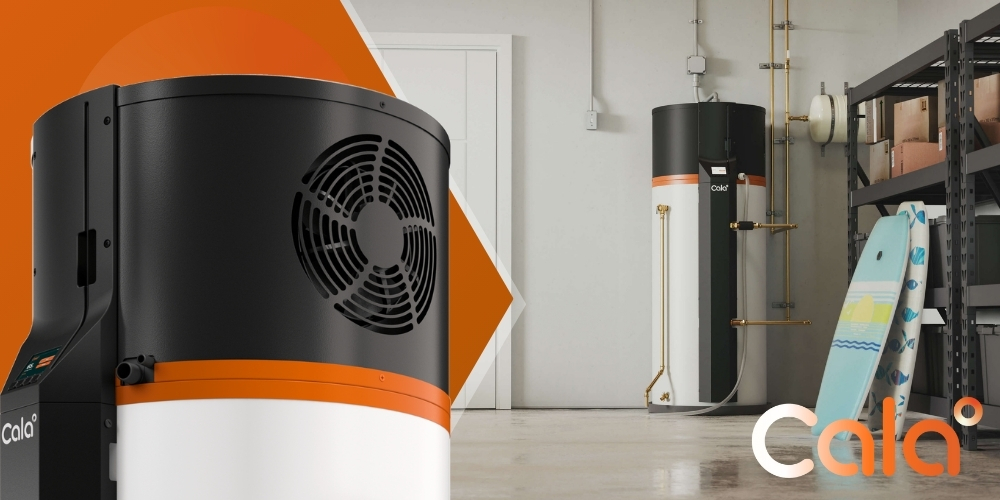Top Mistakes to Avoid When Installing a Make-Up Air Unit

Intelligent Heat Pump Water Heaters for Massachusetts Residential Homes — Why SumZero Selects Cala
By SumZero Energy Systems — Massachusetts’ #1 Heat Pump Installation Team
Picking a new water heater once involved a simple decision between gas and standard old electric, praying the hot water wouldn't be gone when there were two showers in a row. That's no longer the case. Now, the ideal solution for the majority of Massachusetts homes is a smart heat pump water heater (HPWH). This isn't the typical hybrid of which you might have heard, but a rather new breed of unit that adapts to your home's schedule, accommodates your energy usage, and maintains comfort consistently while consuming a lot less energy.
When homeowners want to have it exactly right the first time, our team is discerning about what products we choose. We consider the landscape and inspect the details before determining that they might work with Cala, a company that produces a high-technology hot water heater that modern homes need: intelligent, consistent, and efficient hot water — installed properly. This article describes why this alliance matters, how the tech benefits your home, what you should expect from our installation, and the handy information (rebates, credits, fit questions) homeowners inquire about daily.
Why This Alliance Is Important
(and What It Does for You)
There are two parts to a successful hot water solution:
Great technology
A system that makes you comfortable and uses less energy.
Great installation
Design, placement, airflow, electrical, condensate handling, commissioning, and long-term support.
Cala provides a tailor-built, smart HPWH platform. SumZero provides actual-world experience so that it works perfectly in real Massachusetts homes.
Together, we provide three things homeowners report wanting:
Accurate hot water at peak periods without guessing.
Cheaper monthly energy bills without compromise on comfort.
It is a future-proof solution that addresses the trend towards greener, all-electric homes.
Simply put: We get hot water. We know how to properly install heat pump technology. This combination makes a water heater upgrade a smart, long-term decision.
The Homeowner's Dilemma That We Are
If you have had a gas or a typical electric water heater, then you know the problems:
Hot-cold swings on hectic morning routines.
Higher electricity bills than hoped for.
No real insight, no real control.
A replace cycle that is experienced as "buying the same thing again."
Typical hybrid: Heat pump water heaters perform better, yet they still react: They delay until the tank cools off, then warm it up again. Homeowners averred they desire a system which thinks ahead—a unit which is a breeze to operate, handles peak load graciously, and does not make them compromise.
They fill that gap, which is why we work with them.

Why a Smart HPWH is Different
A standard electric water heater makes heat by passing an electric element, a giant toaster coil, through the tank. A heat pump water heater does it another way: it takes heat from the air it lives in and puts it into the water. Because it costs less energy to move heat than create it, heat pump water heaters run on much less power than typical electric ones. And they avoid burning gas, venting, and pollution.
A smart HPWH goes one step further:
It adapts to your home's schedule (morning showers, nighttime laundry) and preheats when demand isn't yet high.
You can use the app to check, plan, or increase hot water whenever you want.
It has a compressor that can change speed to fit what you need (not just "on/off").
It is achievable with a mixing valve holding water at the proper warmth for improved efficiency and then providing a sustained, safe warmth for usage. This is also possible with the availability of additional warm water at peak usage times.
It goes nicely with a contemporary home — primed for solar, time-of-use, and information you can view at a glance.
Result: more stable comfort, less energy use, improved control.
Why a Smart HPWH is Different
From what is visible on-site, there are three things certain for homeowners regarding the points of Cala:
1) Ease That Is Effortless
Consistent hot water at peak use is the ultimate test. Through forecasting demand and using a mixing valve, Cala maintains a steady supply. That results in less "uh oh" when two showers coincidentally happen at once or someone turns on the dishwasher.
2) Controls That You'll Ever Use
App functionality is key when done properly. You can check if there's hot water, turn up the heat for guests, view energy usage history, or simply set it and leave. As installers, we appreciate performance data — it allows us to address little issues before large ones form.
3) Future-Ready from Day One
Massachusetts is going towards clean, electricity-based homes. Cala's strategy combines well: it is scalable for solar power and accounts for time-of-use rates when needed. If you foresee solar energy at some time, or already have it, this water heater won't stop your home from being efficient.
4) A Company That Stands Behind Its Product
Cala backs every unit with a 10-year parts warranty and 3-year labor warranty — a strong sign they stand behind both the technology and the people who install it. At SumZero, we respect that kind of commitment because it mirrors our own approach: taking care of homeowners and supporting our partners with the same level of trust and accountability.
What SumZero Offers As Your Installer
(Why It Matters)
Even the best system won't work so great if installed wrong. Our task is getting your new HPWH working perfectly inside your home, not on a drawing board. This is what our approach is:
Right-size design.
We measure how much water your home needs and discuss the high-flow fixtures, filling bathtubs, and washer usage.
Best installation and ventilation.
HPWHs require air to make the heat move. We consider the room size, doors, vents, and — when necessary — ducting solutions for high performance and low noise.
Clean handling of electricity and condensate.
Safe power, tidy routing, and a trustworthy drainage plan are essential.
Commissioning correctly.
We don't just "turn it on." We verify performance, position the mixing valve, help you with the app, and verify your comfort objectives.
Rebates, credits, and financial assistance.
Mass Save, federal 25C, and the 0% HEAT Loan (if applicable) — we'll help you with that.
We take special care.
Our teams respect your home, protect your floors, and leave the place nicer than they found it.
Aftercare you can count on. Questions years down the road? We're here. The whole concept of a smart system is long-term confidence, not a one-day installation.
Costs, Incentives, and Lifetime Value
Two parts matter here: upfront cost and operating cost.
→ It is a better unit than a standard electric or simple hybrid. Tax credits and rebates make a big difference. A lot of Massachusetts homeowners rely on the 0% HEAT Loan for easier payments.
→ Month after month, the intelligent HPWH's effectiveness is where the value lies. By transferring (not creating) heat and by scheduling heating intelligently, homeowners consistently experience significant decreases in water-heating energy consumption — particularly relative to resistance electric, and many times relative to gas or delivered fuels when full costs are factors.
If you'd like figures specific to your home (household number, showering usage, energy costs), we'll do the math at your consult and provide you with a clear estimate of payback, lifetime cost saving, and the rebates for which you qualify.
Are Smarter Heat Pump Water Heaters Good for Your Home?
It is feasible for many Massachusetts homes. We will cover:
→ Household size and routines. Families with up to about 5 people usually do well with the standard setup; we will give advice for larger families or special situations.
→ Space and ventilation. We check the space, door vents, or ducts if necessary, and ventilation so the system operates properly.
→ Location. Basements are typical, as are utility rooms. As the unit functions, it removes air that feels like a dehumidifier — a typical plus for basements.
→ Electrical. We check panel capacity and proper wiring; no installation day surprises.
→ Future plans. Now or in the future for solar? Time-of-use rates? We'll put the system on so it grows with your home.
[[cta-heatpump]]
Why Is Cala Different from "Traditional Hybrids"?
✪ Control and Convenience:
Cala integrates intelligent tech with a mixing valve to remain comfortable, even when it is busy. Most standard hybrid units have simple modes and react only when the tank becomes chilled.
✪ Care and Trust:
Performance insights help you recognize problems early on and keep you on your feet for surprises. Traditional deployments are mostly "wait and see."
✪ Timing and Efficiency:
Variable driving and improved scheduling assist in energy saving with the maintenance of comfort. Ordinary hybrids operate more often and at undesirable times.
✪ Future-Ready
The design of the Cala accommodates with solar power, intelligent homes, and plans for utilizing electricity. Most older hybrids were not built for that usage.

What to Expect with SumZero
(From the First Call Through the First Shower)
✪ Talk & Pictures
We'll first glance at your objectives and take some fast photos of the current installation: the water heating unit, panel, and surrounding room.
✪ Right-Fit Design
We fit your hot water consumption and available spaces to a design which we endorse.
✪ Chaplain: A Comprehensive
Your quote is going to be transparent, includes information for installation, accessories, and a checklist for incentives. The paperwork assistance takes care of our end.
✪ Professional Installation
Licensed, insured, and detail-orientated. We dispose of the old unit, prepare the site, install and commission a new system, and leave the site tidy.
✪ App Introduction and Instructions
You'll discover how to see hot water supply, schedule increases, and view consumption — without being "technical."
✪ Support and Help
We're your long-term partner. Got a question? You call us — that's what homeowners deserve from the #1 heat pump installation company.
Common Questions We Get
(And Easy Answers)
Smart heat pump water heaters move heat from the surrounding air into the water instead of generating heat directly. This makes them up to three to four times more efficient than standard electric models. Cala’s intelligent system takes it further — it learns your household’s patterns, preheats before busy periods, and gives you app-based control to monitor or boost hot water anytime.
Most hybrid water heaters react when the tank cools. Cala predicts when your home will need hot water and heats proactively, saving more energy while maintaining comfort. It also features a variable-speed compressor, integrated mixing valve, and performance monitoring portal, giving both homeowners and installers a smarter, more reliable experience.
Savings depend on your energy source and usage, but many Massachusetts homeowners cut their water-heating costs by 50–70% when switching to a heat pump system. Cala’s intelligent controls add even greater efficiency. Add Mass Save® rebates, federal 25C tax credits, and potential 0% HEAT Loan financing, and most families see real payback within just a few years.
Yes — most Massachusetts homes are a great fit. Cala’s 65-gallon design comfortably serves households up to five people and can prepare up to 90 gallons ahead of peak use. The system needs adequate space and airflow, similar to a dehumidifier, and our team at SumZero handles every detail — from placement and ducting to electrical and performance checks.
SumZero Energy Systems is Massachusetts’ #1 heat pump installation team, trusted for precision, transparency, and high-quality service. We manage every step — design, installation, rebate paperwork, app setup, and long-term maintenance — so homeowners enjoy smarter comfort and lasting confidence. With SumZero, you’re not just buying equipment; you’re gaining a partner who stands behind it.
Why We Feel Secure Recommending This to Massachusetts Homeowners
We have a simple promise: we only install solutions that we would use in our own homes. Cala’s approach — being smart, having control, and being ready for the future — matches what we have learned from many talks with homeowners in the state. Together with SumZero’s careful installation standards and ongoing support, this water-heating upgrade makes sense right away and will last well with your home. Cleaner heat. Smarter comfort. Fewer bills.
Ready to Take the Next Step?

To learn more about Cala’s technology and vision, visit Cala Systems.
The Top Mistakes to Avoid When Installing a Make-Up Air Unit in Massachusetts Homes
Poor indoor air quality isn’t just uncomfortable—it can also lead to long-term issues for your home and health. In Massachusetts, where homes are sealed tightly to conserve heating and cooling energy, installing a make-up air unit becomes especially important. Yet, many homeowners rush through the installation process, leading to costly mistakes they regret later. Understanding how to install make up air for range hood systems efficiently is critical to reaping the full benefits.
Let’s explore the most common missteps and how you can avoid them when installing make-up air in your home.
Ignoring Local Building Codes and Energy Requirements
Massachusetts has some of the most progressive building standards in the country, particularly when it comes to ventilation and indoor air quality. Failure to comply with these not only risks code violations but could also reduce the efficiency of your new system.
Understand Massachusetts-Specific Ventilation Codes
Before installing any equipment, check how your project aligns with Massachusetts building codes related to mechanical ventilation. Make-up air systems often fall under energy and exhaust regulations, especially in kitchens.
- Smoke and grease-producing appliances typically require dedicated make-up air
- Range hoods over 400 CFM usually must be paired with a make-up air system
- Backdraft dampers might be required for compliance
According to the Massachusetts Residential Code, range hoods exhausting more than 400 CFM must include a make-up air system that automatically activates when the fan is on.
Make Sure to Account for Mass Save® Guidelines
Homeowners in Massachusetts may be eligible for rebates or efficiency incentives through programs like Mass Save®, but only if the system meets specific requirements.
- Ensure the equipment is rated for energy efficiency
- Submit the proper documentation post-installation
- Choose models that integrate well with energy incentives
Choosing the Wrong Size or Placement for Your Make-Up Air Unit
Many homeowners underestimate the importance of choosing the correct size and location for their air unit. Oversizing leads to energy waste and discomfort, while undersizing makes it ineffective.
Match the Unit Size to Your Exhaust System
To optimize airflow exchange, your make-up air unit must balance exactly—or almost exactly—what your kitchen vent hood removes. This becomes critical in homes where powerful range hoods are used.
- Measure range hood CFM to determine airflow needs
- Align make-up air unit CFM to within 10% of exhaust output
- Consider total home ventilation load if multiple exhaust fans exist
Oversizing a make-up air unit by just 20% can lead to drafty kitchens, elevated heating bills, and inconsistent indoor temperatures during Massachusetts winters.
Placement Matters More Than You Think
Where you position your make-up air intake impacts not only efficiency but also comfort. Cold outdoor air rushing in near high-use areas like dining rooms or bedrooms can cause discomfort, especially in winter.
- Avoid placements close to seating or food prep areas
- Integrate with HVAC ductwork for even air distribution
- Install air tempering devices if near exterior walls
This is an ideal point to consider your home's broader energy landscape. If your kitchen range isn’t the only part of your home creating ventilation challenges, it may be time to look at a more holistic solution.
[[cta-heatpump]]
Skipping Proper Ducting and Dampers
A mistake as simple as poor ducting can cancel out the benefits of your new system. Homeowners often assume that adding a return vent is enough—which leads to inefficient airflow and pressure issues over time.
Use Proper Duct Sizes and Materials
When planning make up air installation, your duct system should match the airflow specs of your unit—not just fit in available wall space.
- Use smooth-walled metal ducts, not flexible plastic ones
- Match duct diameter to CFM requirements of the unit
- Keep duct runs as short and straight as possible to reduce resistance
Always Install Automatic Dampers
Dampers are critical components that prevent unwanted air intrusion when the system is off. In Massachusetts, a backdraft of cold winter air can quickly undermine your heating system.
- Choose motorized dampers that activate with the range hood
- Install dampers with built-in seals to prevent energy loss
- Regularly test damper function seasonally
A duct without a functioning damper can result in cold air leakage equivalent to leaving a small window open all winter long in your kitchen.
Forgetting to Temper Incoming Air in Cold Months
Massachusetts winters can be brutally cold. Bringing in untreated outdoor air through a make-up system leads to not only discomfort but potential condensation issues in your ductwork and living spaces.
Why Air Tempering Is Essential
When temperatures drop below freezing, letting that air flow into your kitchen creates a blast of cold that can chill occupants and lower indoor temperature.
- Air that's not conditioned can cause ducts to freeze
- May lead to moisture condensation and mold
- Heating systems have to work harder to compensate
Adding a heating element—or choosing a model with built-in tempering—can dramatically increase both comfort and effectiveness.
Options for Tempering Make-Up Air
There are multiple ways to warm up incoming make-up air before it enters your home:
- Electric duct heaters
- Hydronic coils connected to a boiler or water heater
- Heat recovery ventilators (HRVs) for energy efficiency
Many homeowners in Massachusetts are also exploring air-source heat pumps for broader home heating and cooling solutions that can integrate with their ventilation goals.
Not Testing System Performance After Installation
Think you’re done once the system is sealed? Not so fast. If you don't test how well the unit balances pressure and airflow, you might end up with new issues instead of solving the old ones.
Test for Balanced Air Pressure
After connecting your make up air unit installation, run tests to make sure there’s no negative pressure pulling in air from unwanted places like chimneys or attics.
- Use a smoke pen to check airflow direction
- Monitor home humidity and temperature for irregular shifts
- Run exhaust and make-up system simultaneously to validate airflow balance
Verify Indoor Air Quality Post-Installation
Once installed, your system should lead to cleaner, more breathable indoor air—especially important for families dealing with asthma or allergies.
- Check for reduced cooking odors lingering after meals
- Notice less condensation inside windows during the winter
- Confirm your home feels more comfortable during high-usage times like holidays or dinner parties
Properly installed make-up air units not only preserve your kitchen’s comfort, but can also extend the life of your appliances and HVAC systems by reducing strain.
Final Thoughts
Installing a make-up air unit is one of the smartest ways to improve kitchen ventilation and indoor comfort, especially in air-tight, energy-efficient Massachusetts homes. But getting it right requires attention to details many homeowners overlook—proper sizing, Massachusetts code compliance, smart ducting, air tempering, and post-installation testing.
Avoid shortcuts and think of this as an investment into your home’s long-term value and comfort. When installed correctly, a make-up air unit allows you to enjoy the full benefits of your range hood without the downside of uncomfortable drafts, negative pressure, or sky-high heating bills.
Take the time to plan carefully, and your home will return the favor in comfort and energy savings for years to come.
Ensure healthy airflow and year-round comfort in your kitchen—learn how professional make up air installation can help you meet Massachusetts codes and avoid costly ventilation mistakes.
Install Make-Up Air NowYou Might Also Like…
Continue learning with handpicked articles that inform and inspire.
Not Sure Where to Start? We’ll Guide You
Let our experts design the right heating and cooling solution—customized for your comfort, your layout, and your energy goals. No pressure. Just clarity.
Request FREE ESTIMATE









